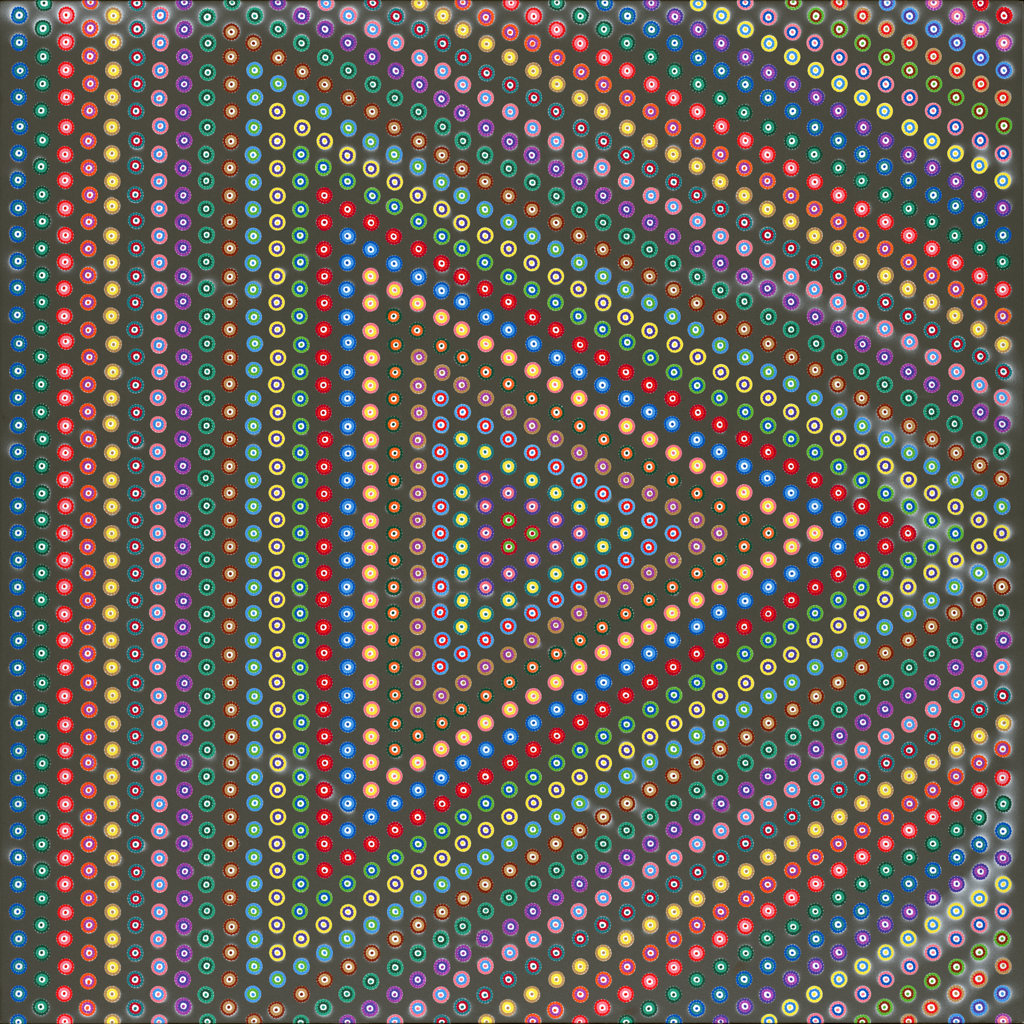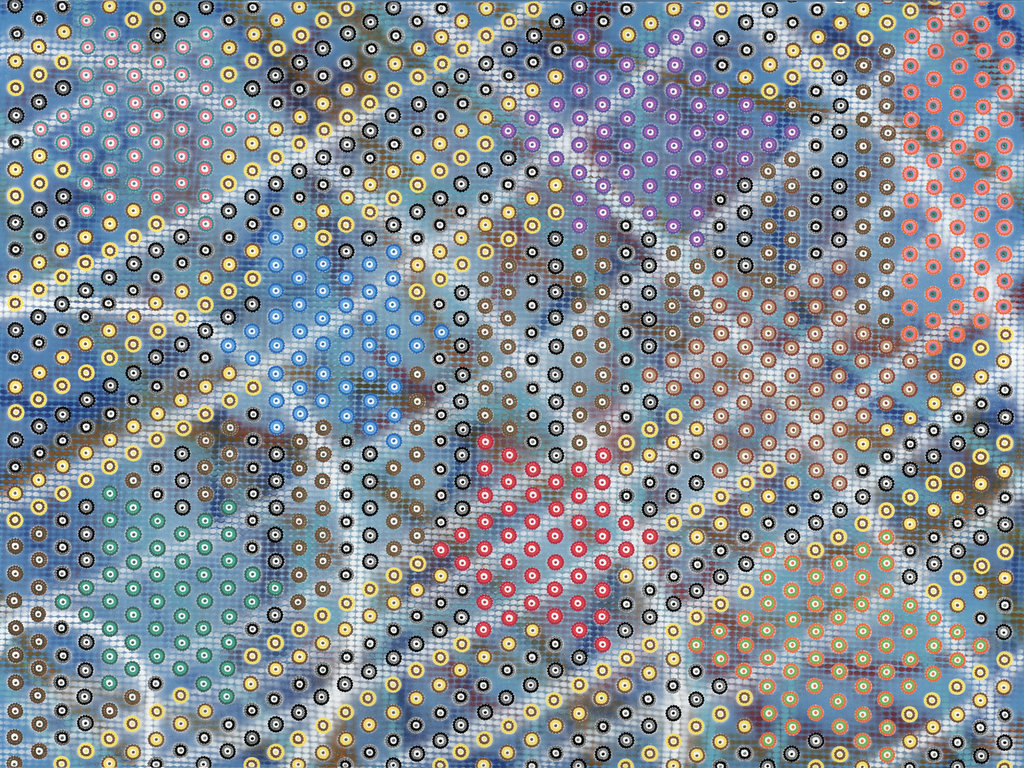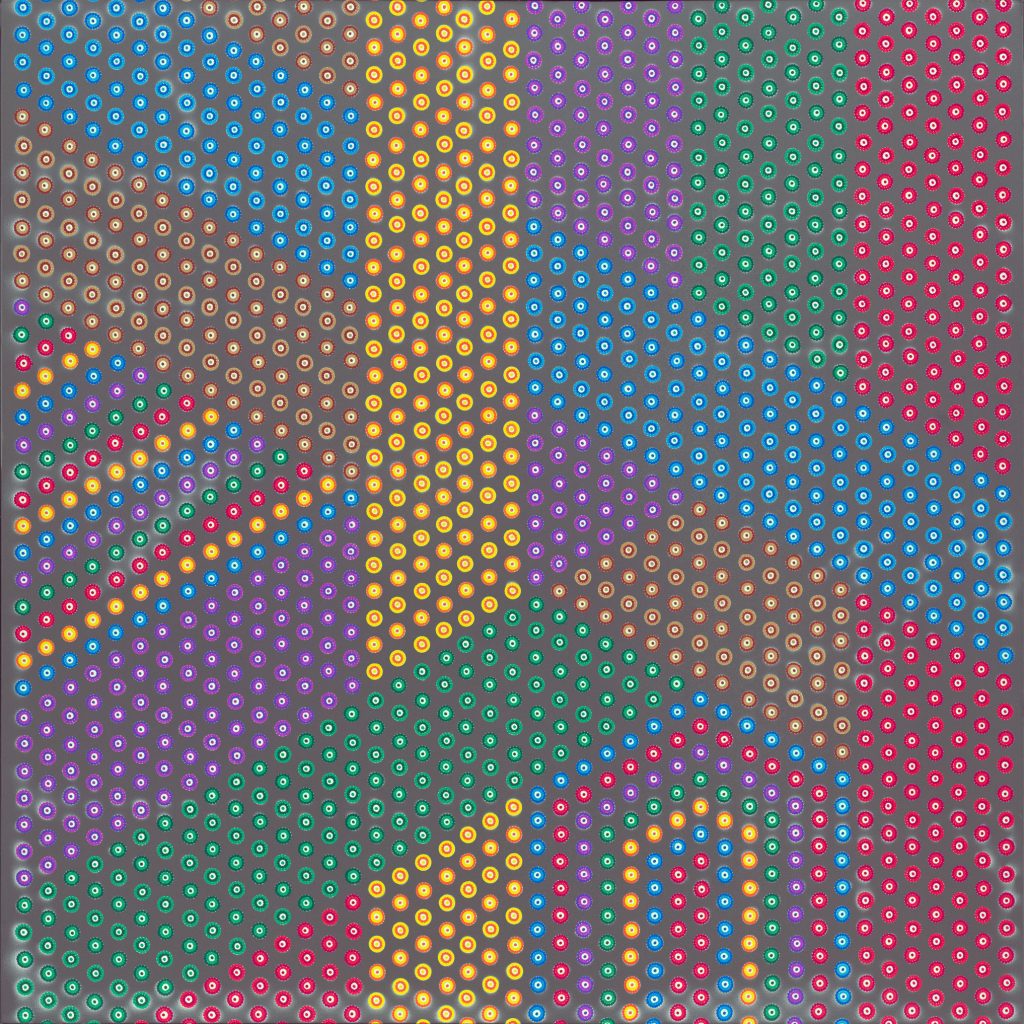Jonathan Brender finds inspiration for his signature style in the pointillist artwork of Aborigines
By Lee Mergner
Venezuelan-born painter Jonathan Brender’s bright pointillism pieces have made him popular with collectors in the United States and Europe. The South Florida resident, who first received his artistic education in ceramics and sculpture, spoke with ABN contributor Lee Mergner at Spectrum Miami, where he contemplated light, inspiration, and the changing nature of art as a career.
Art Business News: Do you remember your first piece of work that others recognized?
Jonathan Brender: I do remember. The beginnings of my art were from a trip I took to Australia in the back country where the Aborigines live. I stayed there for two months learning their art of pointillism. They used to do big faces with a million dots—aborigine faces, maybe kangaroos. I was so amazed at their patience and how many points [it took]. I started modifying that art into [portraits of] modern icons. My first [pointillism piece] was a face of Bob Marley, which had immediate success in my exposition in London. Then I knew I had something going on, something different from other artists. I started pursuing that, and, in two years’ time, I started attending Spectrum and other shows, and it just skyrocketed.
I can only make 10 to 12 paintings a year because it takes that much time, and physically it takes a toll on my shoulders and on my fingers. Once I started selling out all my yearly productions or collections, I knew that I really had something special and different.
ABN: What drew you to that form?
JB: I think it’s the time-consuming aspect of each painting. I need that time consumption to maintain my mind in the same way. For me, working eight hours, 10 hours, 12 hours a day for a month and a half doing only points … keeps me from going insane.
ABN: For most people it would be the opposite! Do you listen to music while working?
JB: Yes, only classical and jazz. And, [contrary to] what people might think, I can’t drink a drop of alcohol when I’m painting because I cannot have my hands shake even just an itty bit. When I’m painting, I’m at my most sober time.
 ABN: How has your work evolved over the years?
ABN: How has your work evolved over the years?
JB: I’ve been doing this for 15 years. It has evolved, first of all, in the number of dots I do. When I started out, I did 20,000 or 25,000 dots. Now, I’m up to 180,000 dots. Also, I’m incorporating a few UV tints and inks that work only in darkness or with a UV light. I’m also doing some geometrical forms that you can see only from far away, and, from near you can see only the dots. I think I’ve come a long way.
ABN: What is your relationship with the people who buy your art?
JB: Usually, nowadays, I don’t even meet my clients. When I started out, I sold them personally to each of my clients. Now, it has become somewhat of a real business, where my PR manager takes care of all the sales. It’s really strange when I meet the real buyer. And they’re mostly from Europe. I really don’t get to meet them personally, which is something I really would like to do.
ABN: Why has Europe been a better market for you?
JB: I was born in Venezuela, but I’m an American. The place to be historically for art, besides Europe, is America. I collect pop art from American artists, which is hugely collectible. But Europeans, I think, buy more art. I think Americans buy more expensive art but fewer pieces. But Europeans like the emerging artists. They’ll buy an entire collection of one emerging artist. It’s a different market. It’s really interesting—the chemistry between the European buyers and the American buyers. It’s totally different.
ABN: How has technology changed the business side for you?
JB: That’s something I’m still trying to adapt to. A hand-painting artist [like myself] doesn’t have the time for this new media—Facebook, Instagram, and whatever. You get to the point where you have to hire somebody to manage that. But if you don’t have sales, then you can’t manage that. So you’re without an arm or a leg. Thank God I do sell out my collections each year, so I have two people to take care of that. It’s a really important part of being an artist in this day.
ABN: Technology has changed things for the galleries, as well.
JB: Nobody walks into a gallery now unless they have bought from there before. Now you go online and you have 100 pages—Saatchi, Amazon, whatever—that specialize in handmade art. Now you don’t have to walk through three or five or eight galleries. Now you just go online and find whatever you’re looking for. People who buy art … have something on their mind that they really want to buy. They have to research. The technology now goes like the left hand with the right hand for the artists and their paintings.
ABN: But it’s hard to really experience the 3D and tactile aspects of art online. A JPEG is very different from a piece of art.
JB: On my website, you can see my paintings, but you can’t really appreciate each of the dots I do because it’s a digital image. You have to look at it closely. For me as an artist, it’s hard that people like to look first at the work on a computer. Art is supposed to be seen in real life and in the real light. But you either modify, or you die. You either keep up with the times, or you wither. It’s a fight between the old-school art that we love and cherish and the new age.
 ABN: Light is a big issue for all art, but how does light affect your work?
ABN: Light is a big issue for all art, but how does light affect your work?
JB: I only work with yellow light, and, interestingly enough, I can’t work with light hitting directly on the canvas. I need light to be from any of the sides, so I paint on a light shadow. It’s really different from other painters, who need natural light or white light. I need yellow light and [to be in the] shadows.
ABN: Why is that?
JB: It makes me measure the dots and the position of the dots better.
ABN: Like the filmmakers’ magic hour?
JB: Yes, I actually start at 7 a.m., and when the light gets heavy, I can’t paint anymore.
ABN: What was the last piece of art you saw from another artist that inspired you or struck you?
JB: I can’t think of any emerging artists that really wowed me recently, but I would say that my favorite artist in history is Jackson Pollock. At that date he started doing his style, it was a revolution. No one dared to do that. And the colors he used. It was so simple but yet so shocking. I think the first painting I saw of his was No. 203 or something. I remember my first paintings. I didn’t put names; I put numbers. He was my biggest influence, although my technique has nothing to with that. He was so bold and so risky. And I also identify with his personal life [laughs].
ABN: What do you get from coming to a show like Spectrum Miami or Artexpo New York?
JB: I have a great connection with Spectrum and with Artexpo. First of all, the organization is incredible. The friendliness, for it being an art event, is unbelievable. The networking I see here is really difficult to find in other places, mainly because the ambiance here is not that of old-school galleries. Everybody here is young. There are new galleries. Everybody is on the same page. Nobody thinks they are bigger or better than anybody. Everybody here is the same. This attracts me the most [to] the Redwood shows.


